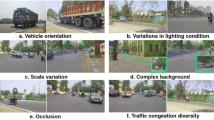Abstract
Vision-based automatic detection and tracking of on-road vehicles is a demanding research area in intelligent transportation systems (ITS). Several investigation reports are available in the literature in this research field using various machine learning (ML) techniques. This article proposes a method for on-road vehicle detection and tracking in varying weather conditions by modifying the structure of you only look once (YOLO), a recently developed deep learning model in computer vision for detecting objects. ML-based systems repurpose classifiers to detect the vehicles, whereas in YOLO model, a single convolutional neural network (CNN) predicts the detecting bounding boxes and the class probabilities for those boxes together in one evaluation from the full images. As the entire detection is performed using a single network, the detection process can be viewed as an end-to-end system. In this work, 16 convolutional layers of YOLO have been used along with two fully connected layers at the end. The vehicles have been detected in varying weather conditions. Two different public data sets, namely CDNet 2014 and LISA 2010 data sets have been used to evaluate the system performance, and it outperforms state-of-the-art results.
Access this chapter
Tax calculation will be finalised at checkout
Purchases are for personal use only
Similar content being viewed by others
References
Singh V, Srivastava A, Kumar S, Ghosh R (2019) A structural feature based automatic vehicle classification system at toll plaza. In: Proceedings of the 4th international conference on internet of things and connected technologies, Jaipur, India, pp 1–10
Ghosh R, Thakre S, Kumar P (2018) A vehicle number plate recognition system using region-of-interest based filtering method. In: Proceedings of the 2018 conference on information and communication technology, Jabalpur, India, pp 1–6
Sun Z, Bebis G, Miller R (2006) Monocular precrash vehicle detection: features and classifiers. IEEE Trans Image Process 15(7):2019–2034
Cheon M, Lee W, Yoon C, Park M (2012) Vision-based vehicle detection system with consideration of the detecting location. IEEE Trans Intell Transp Syst 13(3):1243–1252
Sivaraman S, Trivedi MM (2014) Active learning for on-road vehicle detection: a comparative study. Mach Vis Appl 25(3):599–611
Khairdoost N, Monadjemi SA, Jamshidi K (2013) Front and rear vehicle detection using hypothesis generation and verification. Sig Image Process 4(4):31–50
Yan G, Yu M, Yu Y, Fan L (2016) Real-time vehicle detection using histograms of oriented gradients and AdaBoost classification. Int J Light Electron Opt 127(19):7941–7951
Wen X, Shao L, Fang W, Xue Y (2015) Efficient feature selection and classification for vehicle detection. IEEE Trans Circ Syst Video Technol 25(3):508–517
Ming Q, Jo KH (2011) Vehicle detection using tail light segmentation. In: Proceedings of the 6th international forum on strategic technology, Harbin, China, pp 729–732
Mohamed A, Issam A, Mohamed B, Abdellatif B (2015) Real-time detection of vehicles using the Haar-like features and artificial neuron networks. Procedia Comput. Sci. 73:24–31
Matthews N, An P, Charnley D, Harris C (1996) Vehicle detection and recognition in greyscale imagery. Control Eng. Pract. 4(4):473–479
Zhou Y, Liu L, Shao L, Mellor M (2016) DAVE: a unified framework for fast vehicle detection and annotation. In: Proceedings of the European conference on computer vision, Amsterdam, Netherlands, pp 278–293
Fan Q, Brown L, Smith J (2016) A closer look at faster R-CNN for vehicle detection. In: Proceedings of the IEEE intelligent vehicles symposium, pp 124–129
Redmon J, Divvala SK, Girshick RB, Farhadi A (2016) You only look once: unified, real-time object detection. In: Proceedings of the IEEE conference on computer vision and pattern recognition
Wang Y, Jodoin PM, Porikli F, Konrad J, Benezeth Y, Ishwar P (2014) CDnet 2014:an expanded change detection benchmark dataset. In: Proceedings of the IEEE conference on computer vision and pattern recognition workshops, pp 387–394
Sivaraman S, Trivedi M (2010) A general active-learning framework for on-road vehicle recognition and tracking. IEEE Trans Intell Transp Syst 11(2):267–276
Chan Y, Huang S, Fu L, Hsiao P (2007) Vehicle detection under various lighting conditions by incorporating particle filter. In: Proceedings of the IEEE intelligent transportation systems conference, Seattle, USA, pp 534–539
Chellappa R, Qian G, Zheng Q (2004) Vehicle detection and tracking using acoustic and video sensors. In: Proceedings of the IEEE international conference on acoustics, speech, and signal processing, Montreal, Canada, pp 793–796
Bertozzi M, Broggi A, Castelluccio S (1997) A real-time oriented system for vehicle detection. J Syst Arch 43(1–5):317–325
Tian Y, Dong H, Jia L, Li S (2014) A vehicle re-identification algorithm based on multi-sensor correlation. J Zhejiang Univ Sci C 15(5):372–382
Haselhoff A, Kummert A (2009) An evolutionary optimized vehicle tracker in collaboration with a detection system. In: Proceedings of the IEEE intelligent transportation systems conference, St. Louis, USA
Hadi RA, George LE, Mohammed MJ (2017) A computationally economic novel approach for real-time moving multi-vehicle detection and tracking toward efficient traffic surveillance. Arab J Sci Eng 42:817–831
Author information
Authors and Affiliations
Corresponding author
Editor information
Editors and Affiliations
Rights and permissions
Copyright information
© 2021 The Author(s), under exclusive license to Springer Nature Singapore Pte Ltd.
About this chapter
Cite this chapter
Ghosh, R. (2021). A Modified YOLO Model for On-Road Vehicle Detection in Varying Weather Conditions. In: Singh, B., Coello Coello, C.A., Jindal, P., Verma, P. (eds) Intelligent Computing and Communication Systems. Algorithms for Intelligent Systems. Springer, Singapore. https://doi.org/10.1007/978-981-16-1295-4_5
Download citation
DOI: https://doi.org/10.1007/978-981-16-1295-4_5
Published:
Publisher Name: Springer, Singapore
Print ISBN: 978-981-16-1294-7
Online ISBN: 978-981-16-1295-4
eBook Packages: Intelligent Technologies and RoboticsIntelligent Technologies and Robotics (R0)




